Dracula by Bram Stoker, adapted by Liz Lochhead
Information
- Date
- 15th November 2018
- Society
- Guildburys Theatre Company
- Venue
- The Electric Theatre, Guildford
- Type of Production
- Play
- Director
- Michael Thonger
This adaptation by Liz Lochhead of the Bram Stoker novel focuses on the struggles of its two most compelling characters, Mina and Lucy, as they reach adulthood and are about to marry. The play explores what drives Dracula’s victims ‘to invite him in’ and consent to be fed on. It focuses on feelings, and the taboos, fears and secret temptations of the characters. For a Dracula beginner, like myself, a very interesting and thrilling production, extremely well-constructed, beautifully presented, a feast for all senses.
I must mention the programme. There is a German expression ‘ein Augenschmaus’, which I can translate as a ‘delight or feast for the eyes’. Once again, the Guildburys have provided us with such a delight – all red and black, full of stunning - and shocking – photos; a fine lino- or wood- cut (?) portrait of the Director; excellent Director’s Note; pieces about Liz Lochhead, Bram Stoker and Vlad III Dracula himself; and last but not least a piece on German Expressionism, which inspired the excellent set design which I cannot praise too highly. The only thing lacking, sadly, is acknowledgment of NODA membership, (not even a tiny corner on the Cast/Production page, a tiny crest or logo would do), which would enable Guildburys to enter their consistently superb posters/programmes into the annual NODA competition. Such consistently good programme design deserves recognition, I would say.
Walking into the auditorium and seeing the set, designed by Ian Nichols, was a brilliantly shocking experience, edgy, nervy, threatening, yet also artistically pleasing (I am a fan of this artistic style). Michael Thonger, the Director, wanted this emphasis on surreal and symbolic imagery, and the play would have been the poorer without it. I couldn’t stop looking at it. Original projected still and moving images, criss cross lines and shadows, painted backdrops through odd shaped arches and windows, intriguing and shocking sound effects, and disturbing music all added to the feeling of foreboding. Slanting beds, in one case with a brilliantly asymmetrical bedhead, played very important roles. It is a long time since I have been so taken with a set. So ambitious, so well-done.
Lighting was integral to the success of the play, just as the set and props were. It set the scene, changed the focus, and certainly was used to shock. I particularly remember the use of strong green lighting, some red, but the green was particularly disturbing.
There were wonderful costumes, of all types, the piece de resistance of course being Dracula’s itself. His makeup was astonishingly good too, it must have been fun to do, and I was fascinated by the ‘blood mouths’ of his recently bitten young ladies!
I had never previously read, nor seen a production of any kind of Dracula, so I came upon it completely fresh, untainted by any previous experience of it. I found it completely fascinating, and I have to say, very terrifying. I also viewed it as a kind of historical document, a piece very much of its time. It gave a very clear insight into the Victorian male attitude towards female sexuality.
In the beginning was the lunatic asylum, as I guess it would have been called at that time. The madwoman Renfield talked of her Master, and devoured flies, spiders and birds, as her perplexed nurses tried to deal with her rages and moods. Malin Karp gave us a challenging Renfield, a demanding part she was perfect in. The nurses were a hoot, Nurse Nisbett (Gilly Fick) and Nurse Grice (Pamela Hemelryk), the former kind, the latter harsh. Their interaction with the totally silent Orderly Drinkwater (Edward Woolrich) I found highly amusing, yet also creepy somehow – why didn’t he speak? Two doctors there were, one largely silent, one the specialist psychiatrist Dr Arthur Seward, who seemed a sound, able and kindly practitioner.
Seward went off to Whitby to visit his young friend, the lawyer Jonathan Harker and his fiancée Mina Westerman. Jonathan (Gavin Brennan) was the perfect young fiancé, very much in love, very keen to do everything right, very English in fact. His beloved Mina (a strong performance from Debby Dean), sweet, faithful, honest and true, an upright yet gay young woman, could barely wait to be married, so excited was she. Her younger sister Lucy was a far more complex and disturbing character, who caused Mina considerable worry with her sleepwalking and bizarre behaviour. Lucy was played to perfection by Fiona Buckland Dos Santos, as a kind of sexually awakening, voluptuous, easily tempted young girl, always fondling her long tresses sensuously. The contrast between these loving sisters was so well played by the two actresses.
Of course, Dr Seward falls for Lucy at first sight, which man wouldn’t, and proposed at once. The partnerships of these two couples, and the interaction between this new ‘family’, were heart-warming to watch, well-acted by all four, so cosy, thus strengthening the sense of impending doom.
When Jonathan has to travel to Dracula’s castle on business, the set, lighting, and sound accentuate our sense of unease and foreboding. The casting of Phill Griffith in the role of Dracula was a masterstroke, I can imagine no better one, he played the role superbly (by not overplaying it in fact). We were terrified for innocent Jonathan, terrified for Mina, who waited anxiously for months at home with no news of him. Griffith was menace personified.
Another important role, I felt, was that of Florrie, the sisters’ maid, played very well by Sarah Martin, as a down to earth, natural Yorkshire girl, a contrast to the upright, modern Mina and the sensuous, troubled Lucy.
Kim Ferguson gave a stellar performance as Professor Abraham Van Helsing, the vampire expert and eventual vampire slayer. He was larger than life, very reassuring, a man of thought and action, and his German accent was superb, and never wavered, from start to finish. A pleasure to watch.
I feel also that Van Helsing’s appearances came as a relief due to his clear, audible diction. I did find that some of the actors were hard to follow – whether this was because of the buzz of the air-conditioning in the theatre, or because of their position on the stage, or of a lack of voice projection, I am not sure.
Set changes were frequent and tricky, due particularly to the device of the angled bed – a great idea, incidentally, and essential to the plot – but I wondered why they were not accompanied by some of the atmospheric music we were treated to at the beginning.
These small quibbles aside, the audience were treated to a spine-chilling evening, well-acted, superbly directed throughout, a veritable visual feast. As always, the Guildburys team pulled off the challenge!
Photographs by Jonathan Constant
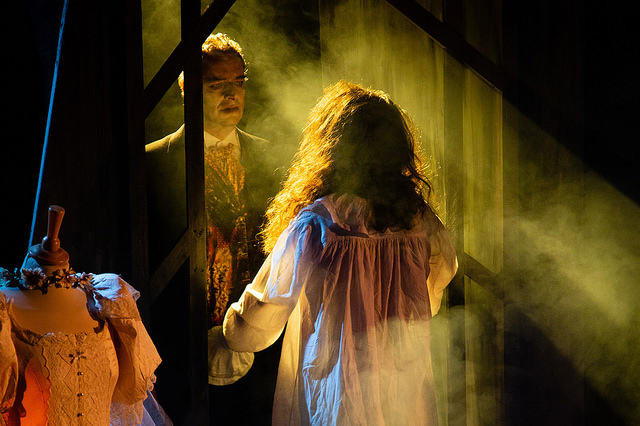
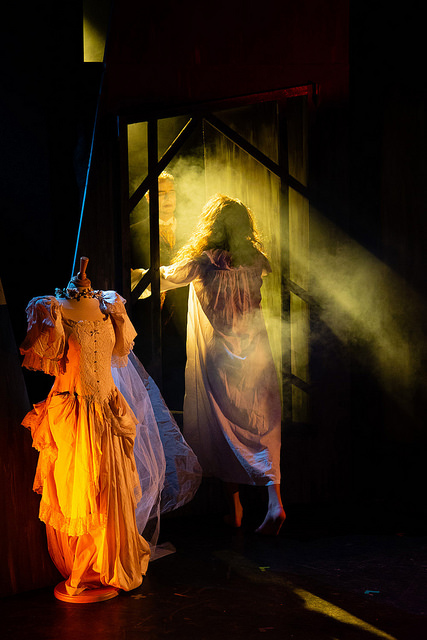
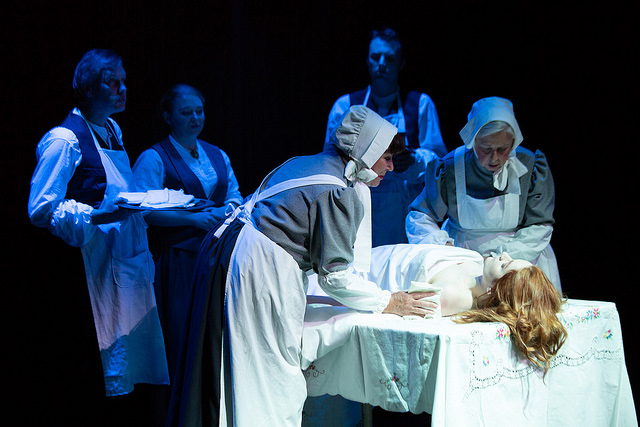
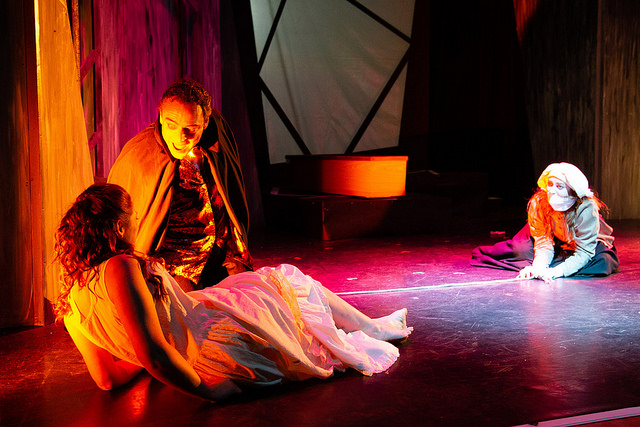
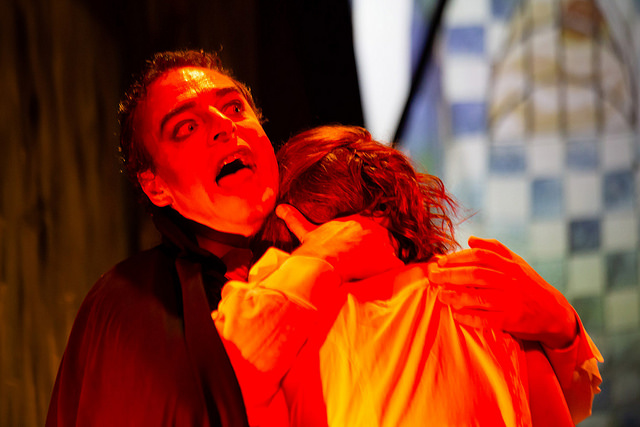
© NODA CIO. All rights reserved.

 Show Reports
Dracula by Bram Stoker, adapted by Liz Lochhead
Show Reports
Dracula by Bram Stoker, adapted by Liz Lochhead